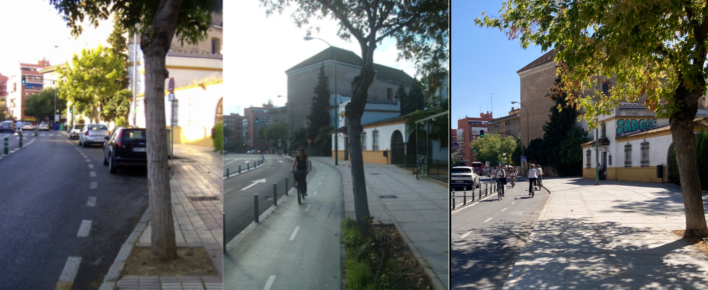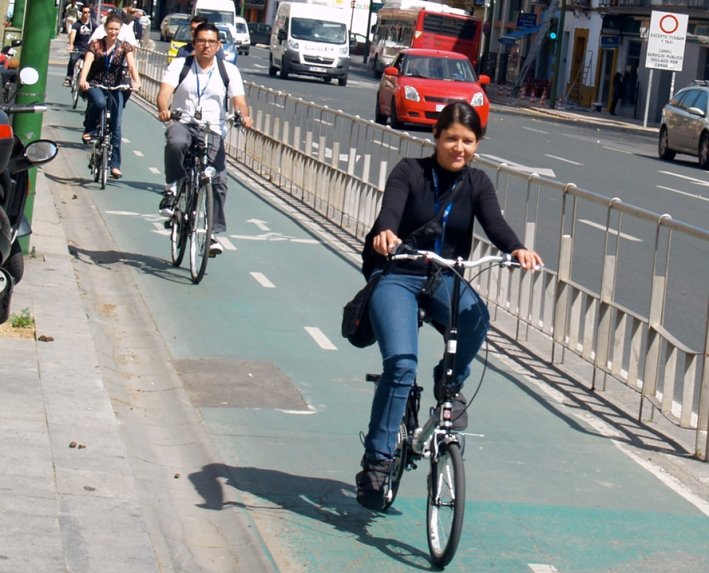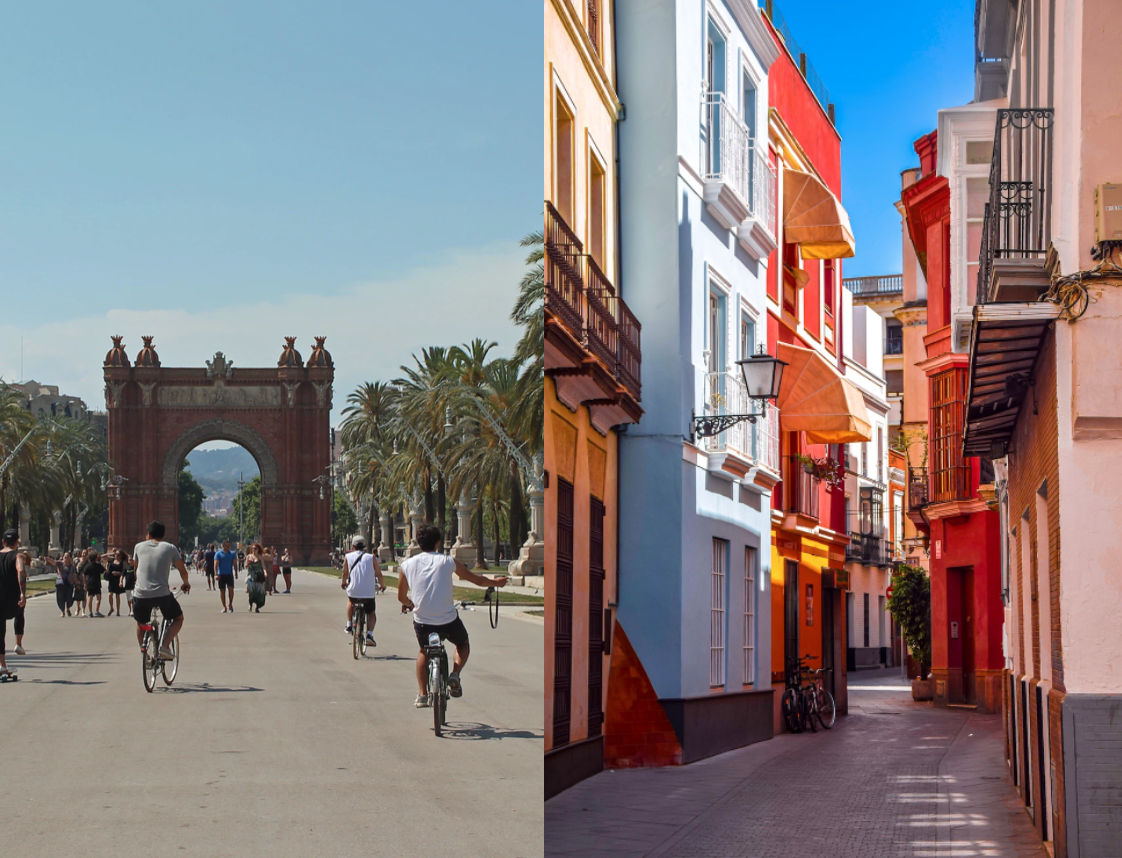Editor's note: This article is part of the “Cycling Through COVID-19” series from world-renowned cycling researchers Ralph Buehler and John Pucher and is published with permission from the authors. In this series, we’ll explore how 14 large cities around the world adjusted their cycling policies during the first years of the COVID-19 pandemic, as well as how those policies contrasted with their approach in the decades prior. In each, Buehler and Pucher also explore how each city’s plans for future investment in cycling inLeffrastructure and programs have been impacted by the pandemic.
Read the rest of the articles in this series as they’re published here, or check out the full paper in Sustainability. This article has been edited slightly for clarity and length.
Barcelona, Spain
Barcelona, with 1.7 million inhabitants (5.3 million in the metro area), has strongly promoted cycling over the past three decades.
For example, the supply of bicycle lanes increased from only 10 kilometers in 1990 to 116 kilometers in 2015. Then, from 2015 to 2019, the city removed about 3000 car-parking spots to increase the total length of bicycle lanes to 209 kilometers, almost doubling the network of lanes in only four years.
In addition to bicycle lanes, cyclists in Barcelona can ride on traffic-calmed streets with speed limits of 30 km/h or lower, which include more than half of all city streets. Barcelona is well-known for its superblocks, 400 × 400 meter areas of multiple city blocks that prioritize pedestrians and cyclists while discouraging vehicular through traffic with physical barriers, one-way traffic, and reduced speed limits.
The average number of bicycle trips per weekday in Barcelona increased almost six-fold over the 15-year period from 2004 to 2019 (from 30,000 to 167,000). Over the same period, the bicycle share of trips in the city quadrupled, rising from 0.7 percent to 2.9 percent. Over the shorter period of 2009 to 2019, the average number of weekday cycling trips doubled for the region, and the share of trips made by bicycle increased from 0.9 to 1.6 percent.
During the COVID-19 pandemic, the number of weekday bicycle trips decreased in Barcelona by eight percent, and in the region by six percent. As trip-making during the week declined overall and more strongly for other modes of transport, the percentage of trips made by bicycle increased slightly (from 2.9 percent to 3.1 percent in the city and 1.6 percent to 1.7 percent regionally).
Bicycle counters along the 550 kilometers long regional trail network (Bicivia) captured bicycle trips on weekends as well. Data show a 34 percent increase in cycling on the trails during 2021 and 2020 compared to 2019. The counters detected fewer cyclists in the city center, but the increases in outlying areas more than offset the decreases. Working and learning from home and a sharp decline in tourism decreased the number of trips made in the city center.

In addition, Barcelona’s popular bikesharing system (Bicing) closed for one month in March 2020 at the onset of the pandemic. Bicing ridership remained much lower in 2020 than in 2019. For example, ridership in June 2020 was only 69 percent of June 2019 ridership.
In response to the COVID-19 pandemic, the city installed 21 kilometers of pop-up bicycle lanes by removing car travel lanes. The city also closed 12 kilometers of roadways to motorized traffic. The new bicycle lanes could be quickly installed because, already in 2019, the city had identified locations for future bicycle lanes
The city intends to make the pop-up bicycle lanes permanent. Moreover, the new 2020 urban mobility plan calls for an additional 33 kilometers of bicycle lanes by 2023 to reach a total network length of 273 kilometers. In addition, design and safety improvements will be made to 12 kilometers of existing bicycle lanes. In the coming years, the city hopes to further expand the bikeway network through local neighborhood initiatives that are supported with funds of the city’s participatory budgeting process, where residents in neighborhoods help decide how to spend city funds allocated to their neighborhood.
Since 2019, Bicing bikesharing has added 2000 electric bicycles that are very popular, averaging 11 trips per day compared to six to seven trips per day for Bicing’s non-motorized bicycles. The city plans to add another 2000 electric bicycles to the Bicing fleet by the end of 2022.
Seville, Spain
Seville, Spain provides a good example of how quickly it is possible to improve bikeway networks and raise cycling levels if there is strong political support for doing so.
From 2003 to 2011, two successive coalition governments were elected that were led by Social Democrats (PSOE), joined by the Greens and Communists. With the vigorous support of cycling advocacy groups, the coalition governments strongly promoted cycling and launched the expansion and improvement of Seville’s protected bikeway network from only 12 kilometers in 2003 to 133 kilometers in 2011. In addition, free on-street bicycle parking was expanded (5700 spaces), and an extensive bikesharing system (2600 bicycles) was introduced.

An indication of the greater safety of the new bikeways is that the rate of cyclists killed or seriously injured per million trips fell by 90 percent (a 10-fold improvement), which might help explain why the percentage of women cyclists rose from 25 percent to 36 percent. The annual number of bicycle trips in Seville increased five-fold from 2003 to 2011, and the bicycle-mode share of trips rose from less than one percent to 5.6 percent.
Unfortunately, that dramatic success was slowed down when the pro-car, anti-cycling Conservative Party came into power in 2011–2014. The new government did not halt bikeway projects already underway. Thus, the bikeway network continued to expand from 133 kilometers in 2011 to 162 kilometers in 2015, and the bikesharing system and bicycle-parking programs were maintained as well.
However, the new city government also lifted restrictions on car use, such as the car-free zone in the historic city center, which immediately increased motor-vehicle traffic and sharply reduced cycling. It also refused to introduce traffic calming in residential neighborhoods and eliminated the entire professional staff of 15 cycling planners and engineers. The cycling share of trips fell from 5.6 percent to four percent.

Although the Social Democrats returned to power in 2015, they were less able to promote cycling than earlier because they were not joined by other members of the former coalition, and thus held only a slim majority. They only slightly expanded the network of protected bikeways from 162 kilometers in 2015 to 180 kilometers in 2019. Cycling levels remained far behind 2011 levels, mainly due to the lack of any car-restraint policies and a slowdown in bicycle-network expansion.
The city did not introduce any special pro-cycling policies during COVID-19. Nevertheless, Seville’s system of protected bikeways further expanded by 4.4 kilometers, and there were extensive improvements in the design of some existing bikeways, which were widened and moved from the sidewalk level to the street level, but still physically separated from motor vehicle traffic.

In sharp contrast to many other European cities, including neighboring Valencia, cycle trips fell by seven percent in Seville from 2019 to 2021. Part of the reason is the boom in the use of stand-up e-scooters, which doubled in ridership from 2019 to 2021, rising from 15 percent to 37 percent of cycling levels. But it also has to do with the fact that the Seville government has not been willing or able to implement policies that effectively restrict car use and further promote cycling beyond current levels. Thus, the COVID-19 pandemic was a “missed opportunity” for promoting cycling in Seville, which had demonstrated such impressive progress and attracted so much international attention as a model cycling city from 2003–2011.
The future may be a bit brighter, however. “Next Generation” funds from the European Union have recently become available to further expand cycling facilities, especially to build connections between the City of Seville and its surrounding suburbs, thus tapping into a suburban population that is roughly the same number as the city itself. In addition, the city plans to continue the engineering design improvements to existing bikeways, as described earlier, to ensure conformance to the most advanced, up-to-date standards.






